Abstract
Choline-containing compounds (Cho) were examined by proton magnetic resonance spectroscopy (1H-MRS) in the left subcortical region, including basal ganglia, in 19 euthymic patients with bipolar disorder and 19 age-matched normal controls. Ten of the patients were treated with lithium; the remaining 9 were not treated with lithium for at least 30 d. The Cho to creatine + phosphocreatine (Cr) peak ratio in the bipolar patients (0.75 +/- 0.38 [mean +/- SD]) was higher than that in the normal controls (0.52 +/- 0.26, P < 0.05). There was no significant difference in the Cho:Cr peak ratio between patients treated with lithium (0.63 +/- 0.36) and without lithium (0.89 +/- 0.35). These results do not support the hypothesis that lithium increases the brain choline-containing compounds, but rather imply that membrane breakdown may occur in the basal ganglia of patients with bipolar disorder.
Full text
PDF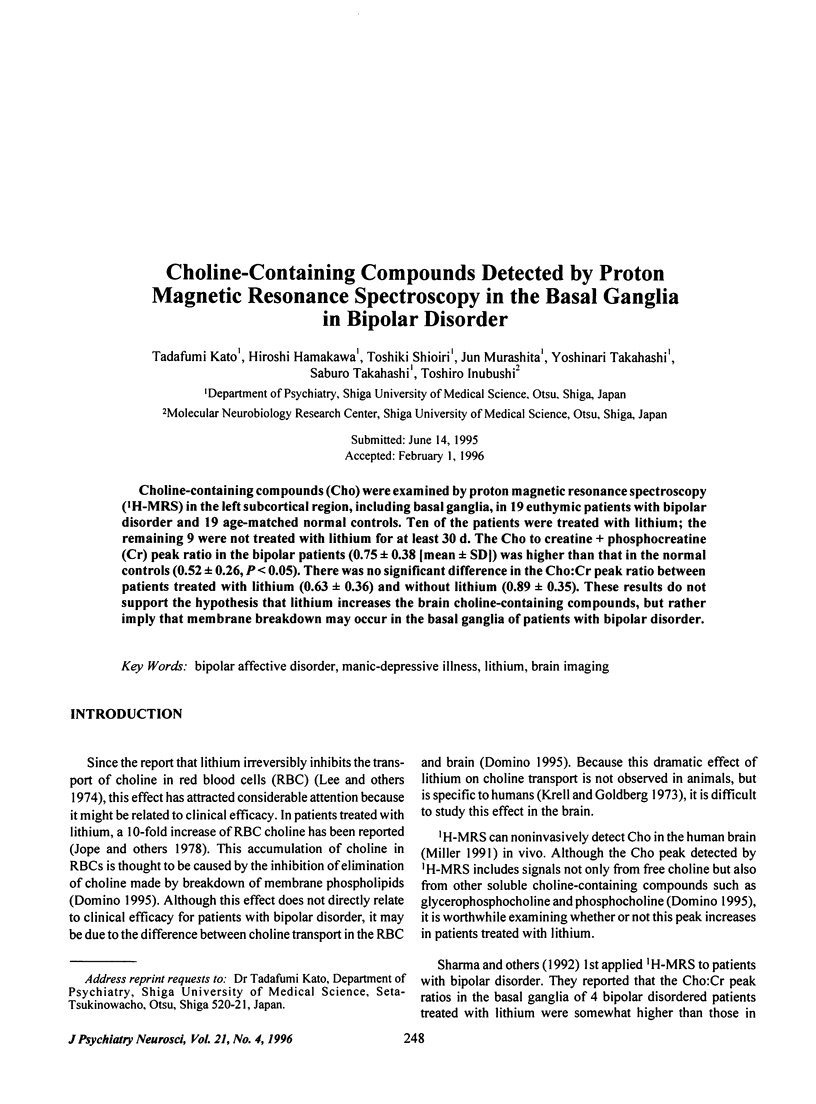
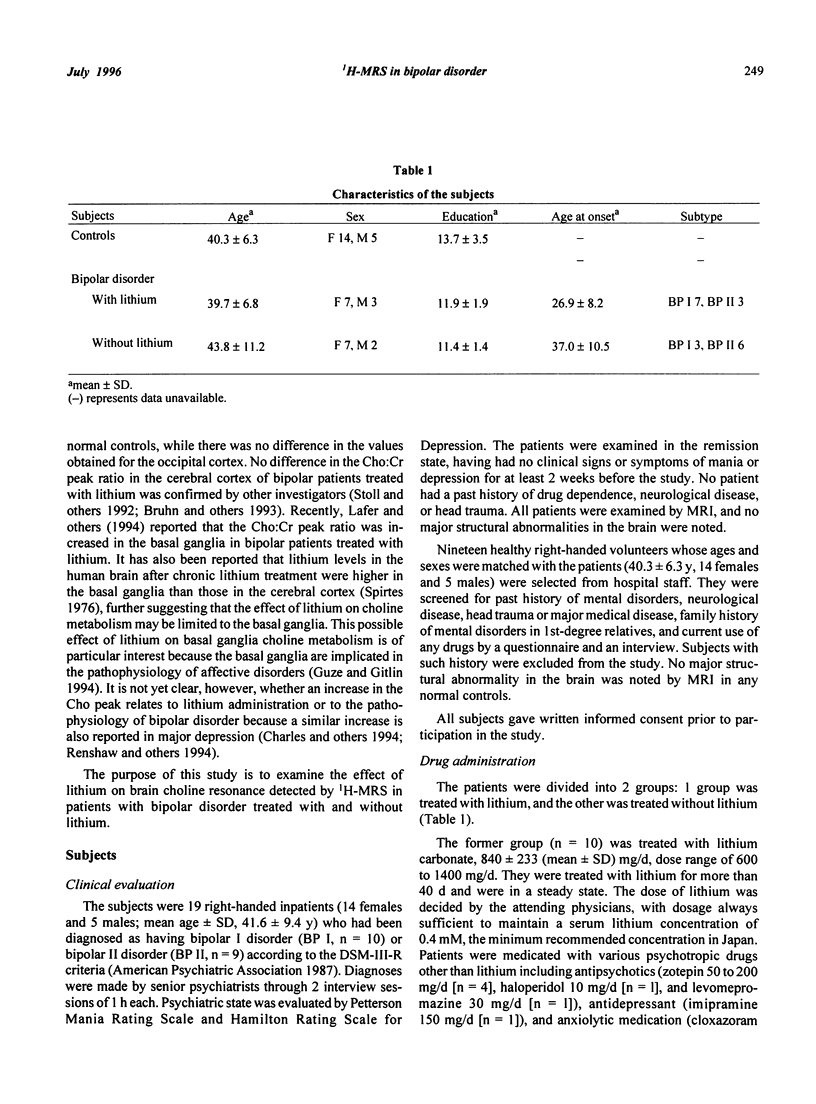
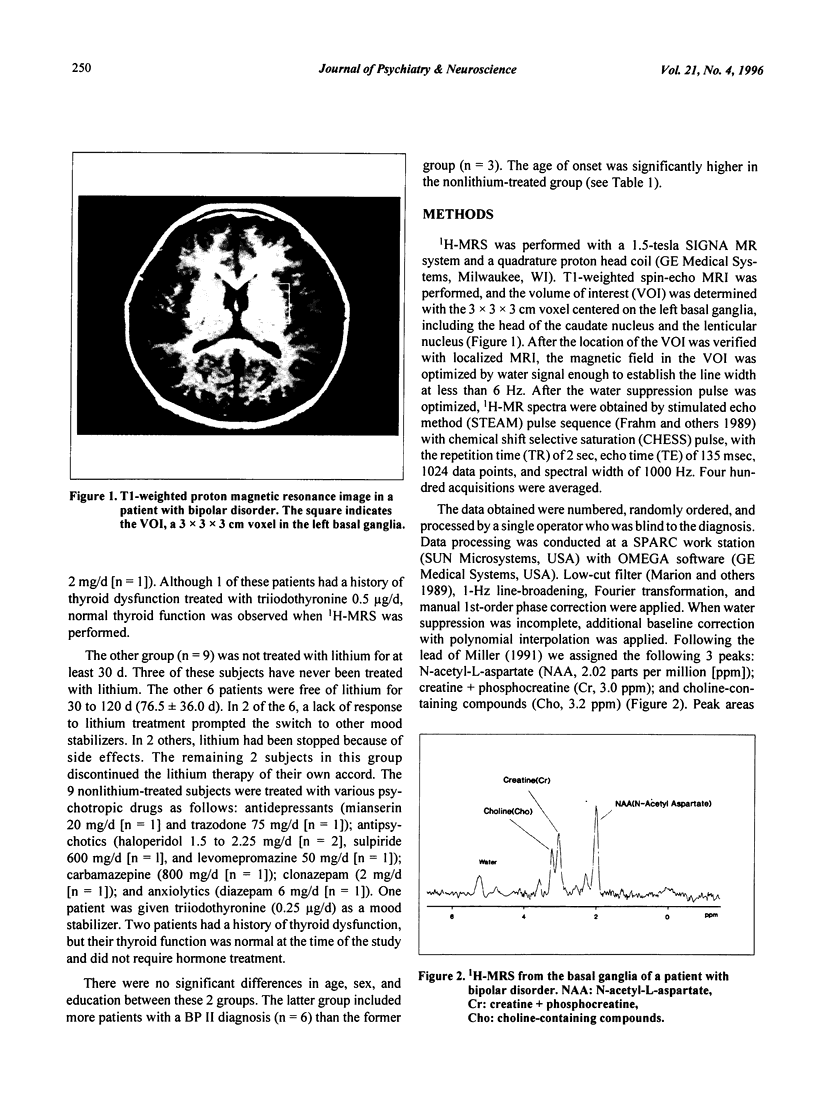
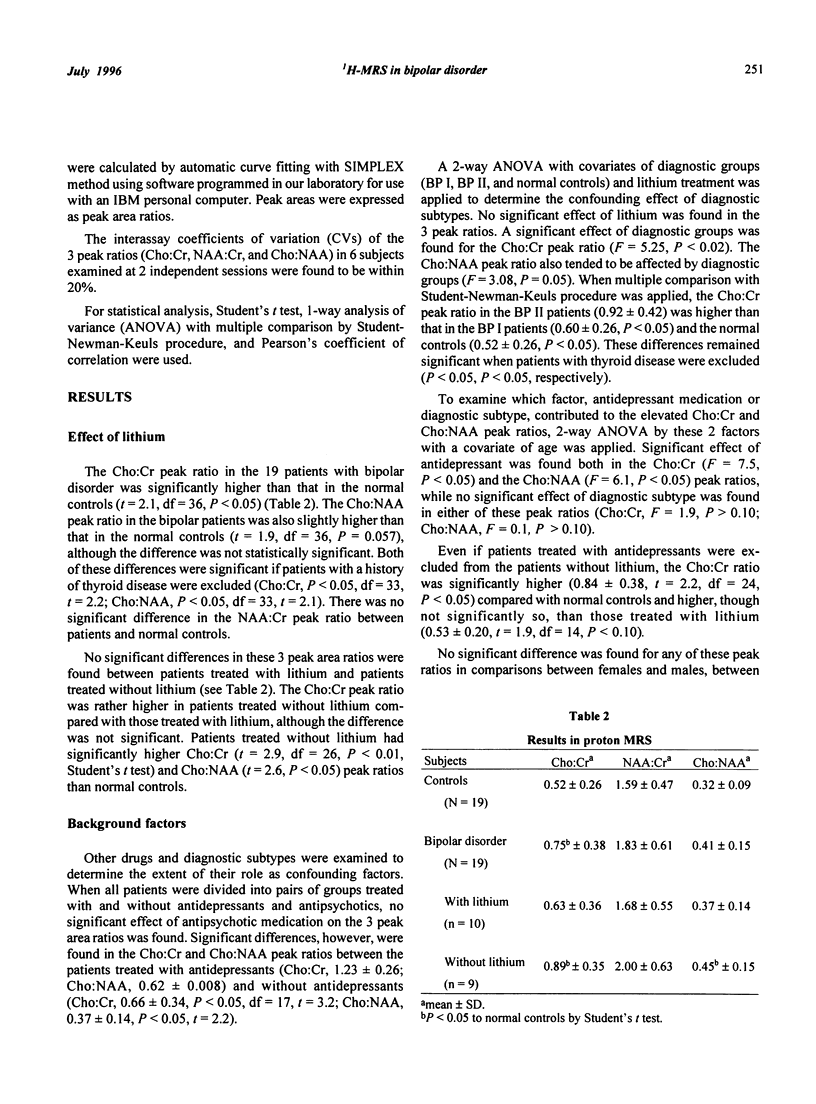
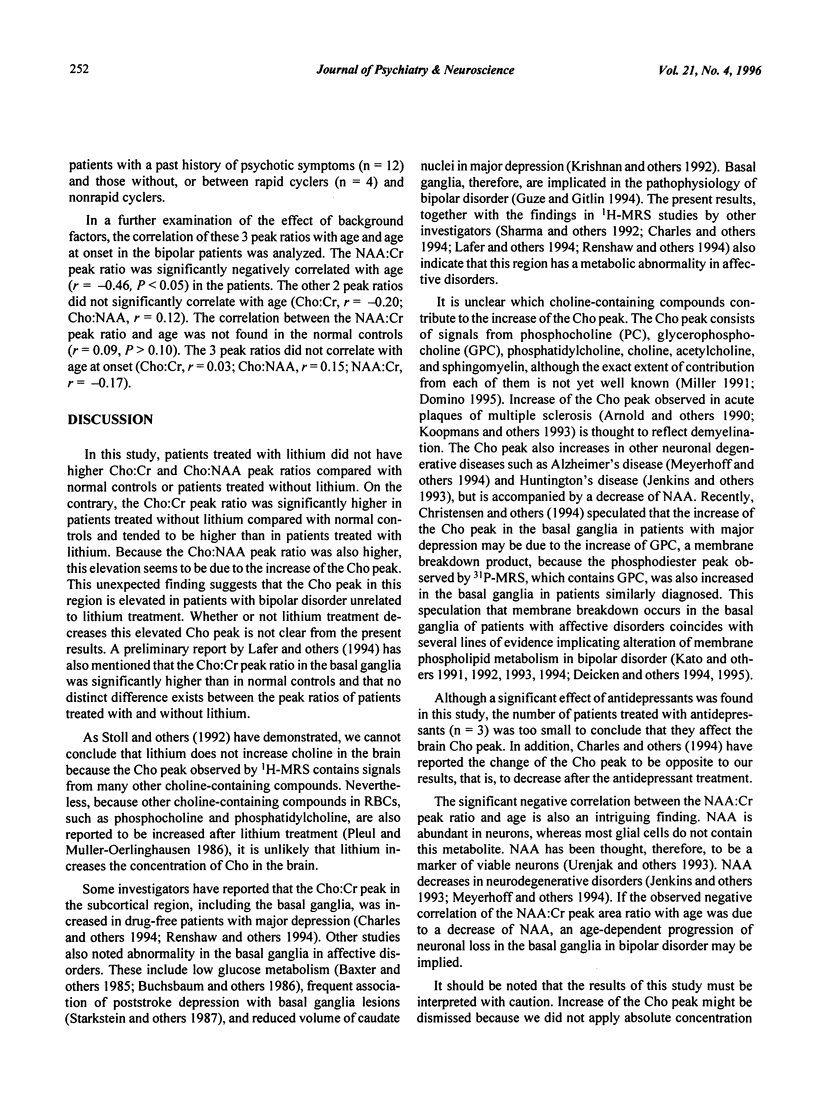
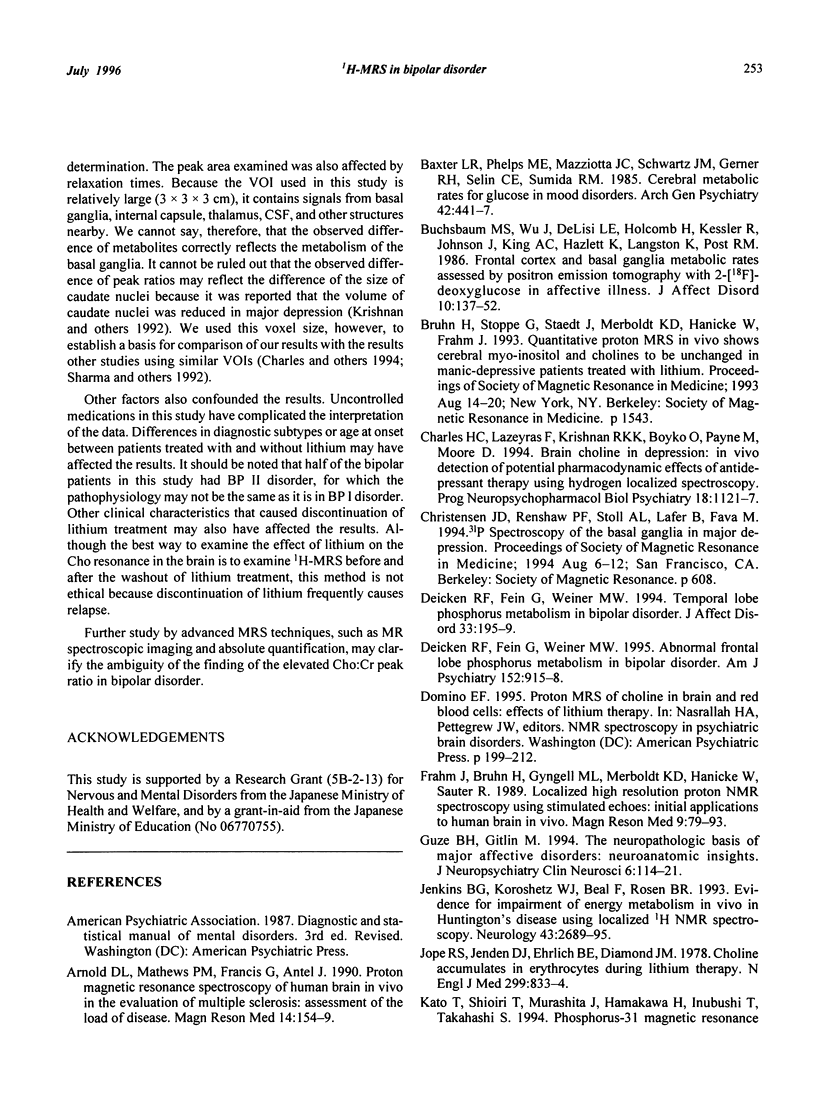
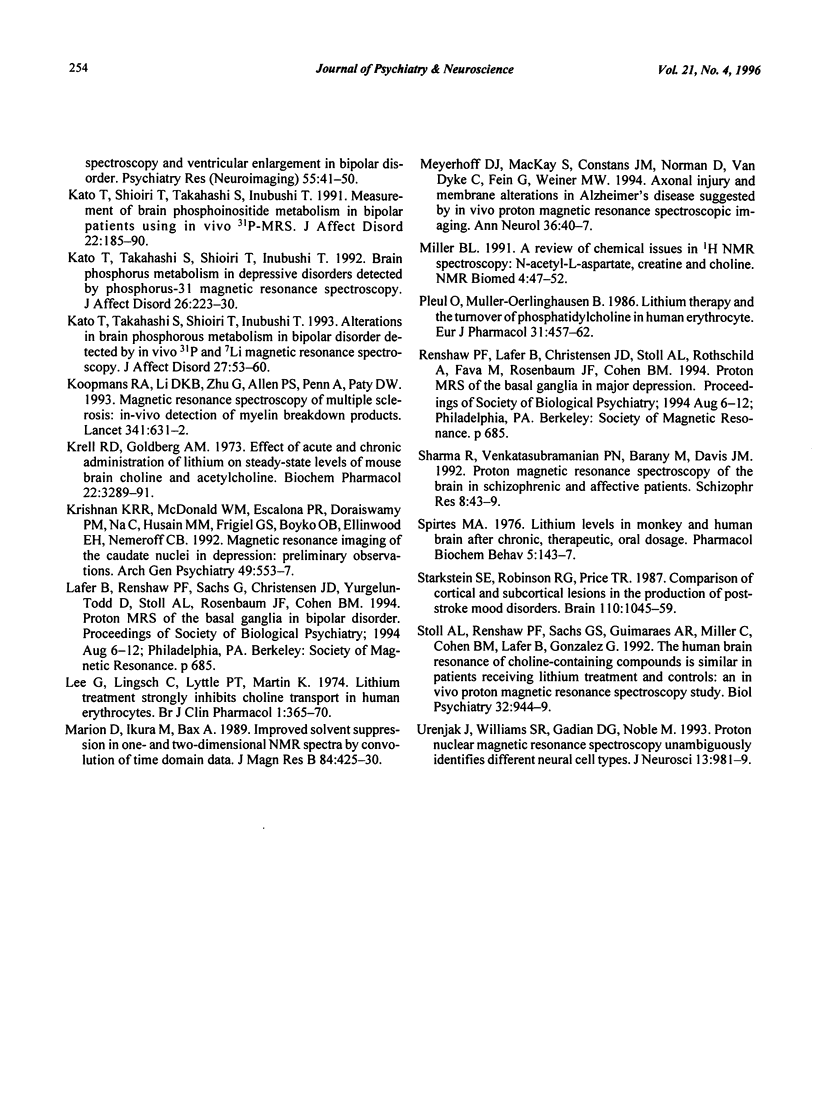
Images in this article
Selected References
These references are in PubMed. This may not be the complete list of references from this article.
- Arnold D. L., Matthews P. M., Francis G., Antel J. Proton magnetic resonance spectroscopy of human brain in vivo in the evaluation of multiple sclerosis: assessment of the load of disease. Magn Reson Med. 1990 Apr;14(1):154–159. doi: 10.1002/mrm.1910140115. [DOI] [PubMed] [Google Scholar]
- Baxter L. R., Jr, Phelps M. E., Mazziotta J. C., Schwartz J. M., Gerner R. H., Selin C. E., Sumida R. M. Cerebral metabolic rates for glucose in mood disorders. Studies with positron emission tomography and fluorodeoxyglucose F 18. Arch Gen Psychiatry. 1985 May;42(5):441–447. doi: 10.1001/archpsyc.1985.01790280019002. [DOI] [PubMed] [Google Scholar]
- Buchsbaum M. S., Wu J., DeLisi L. E., Holcomb H., Kessler R., Johnson J., King A. C., Hazlett E., Langston K., Post R. M. Frontal cortex and basal ganglia metabolic rates assessed by positron emission tomography with [18F]2-deoxyglucose in affective illness. J Affect Disord. 1986 Mar-Apr;10(2):137–152. doi: 10.1016/0165-0327(86)90036-4. [DOI] [PubMed] [Google Scholar]
- Charles H. C., Lazeyras F., Krishnan K. R., Boyko O. B., Payne M., Moore D. Brain choline in depression: in vivo detection of potential pharmacodynamic effects of antidepressant therapy using hydrogen localized spectroscopy. Prog Neuropsychopharmacol Biol Psychiatry. 1994 Nov;18(7):1121–1127. doi: 10.1016/0278-5846(94)90115-5. [DOI] [PubMed] [Google Scholar]
- Deicken R. F., Fein G., Weiner M. W. Abnormal frontal lobe phosphorous metabolism in bipolar disorder. Am J Psychiatry. 1995 Jun;152(6):915–918. doi: 10.1176/ajp.152.6.915. [DOI] [PubMed] [Google Scholar]
- Deicken R. F., Weiner M. W., Fein G. Decreased temporal lobe phosphomonoesters in bipolar disorder. J Affect Disord. 1995 Mar 14;33(3):195–199. doi: 10.1016/0165-0327(94)00089-r. [DOI] [PubMed] [Google Scholar]
- Frahm J., Bruhn H., Gyngell M. L., Merboldt K. D., Hänicke W., Sauter R. Localized high-resolution proton NMR spectroscopy using stimulated echoes: initial applications to human brain in vivo. Magn Reson Med. 1989 Jan;9(1):79–93. doi: 10.1002/mrm.1910090110. [DOI] [PubMed] [Google Scholar]
- Jenkins B. G., Koroshetz W. J., Beal M. F., Rosen B. R. Evidence for impairment of energy metabolism in vivo in Huntington's disease using localized 1H NMR spectroscopy. Neurology. 1993 Dec;43(12):2689–2695. doi: 10.1212/wnl.43.12.2689. [DOI] [PubMed] [Google Scholar]
- Jope R. S., Jenden D. J., Ehrlich B. E., Diamond J. M. Choline accumulates in erythrocytes during lithium therapy. N Engl J Med. 1978 Oct 12;299(15):833–834. [PubMed] [Google Scholar]
- Kato T., Shioiri T., Takahashi S., Inubushi T. Measurement of brain phosphoinositide metabolism in bipolar patients using in vivo 31P-MRS. J Affect Disord. 1991 Aug;22(4):185–190. doi: 10.1016/0165-0327(91)90064-y. [DOI] [PubMed] [Google Scholar]
- Kato T., Takahashi S., Shioiri T., Inubushi T. Alterations in brain phosphorous metabolism in bipolar disorder detected by in vivo 31P and 7Li magnetic resonance spectroscopy. J Affect Disord. 1993 Jan;27(1):53–59. doi: 10.1016/0165-0327(93)90097-4. [DOI] [PubMed] [Google Scholar]
- Kato T., Takahashi S., Shioiri T., Inubushi T. Brain phosphorous metabolism in depressive disorders detected by phosphorus-31 magnetic resonance spectroscopy. J Affect Disord. 1992 Dec;26(4):223–230. doi: 10.1016/0165-0327(92)90099-r. [DOI] [PubMed] [Google Scholar]
- Koopmans R. A., Li D. K., Zhu G., Allen P. S., Penn A., Paty D. W. Magnetic resonance spectroscopy of multiple sclerosis: in-vivo detection of myelin breakdown products. Lancet. 1993 Mar 6;341(8845):631–632. doi: 10.1016/0140-6736(93)90391-s. [DOI] [PubMed] [Google Scholar]
- Krell R. D., Goldberg A. M. Effect of acute and chronic administration of lithium on steady-state levels of mouse brain choline and acetylcholine. Biochem Pharmacol. 1973 Dec 15;22(24):3289–3291. doi: 10.1016/0006-2952(73)90104-4. [DOI] [PubMed] [Google Scholar]
- Krishnan K. R., McDonald W. M., Escalona P. R., Doraiswamy P. M., Na C., Husain M. M., Figiel G. S., Boyko O. B., Ellinwood E. H., Nemeroff C. B. Magnetic resonance imaging of the caudate nuclei in depression. Preliminary observations. Arch Gen Psychiatry. 1992 Jul;49(7):553–557. doi: 10.1001/archpsyc.1992.01820070047007. [DOI] [PubMed] [Google Scholar]
- Meyerhoff D. J., MacKay S., Constans J. M., Norman D., Van Dyke C., Fein G., Weiner M. W. Axonal injury and membrane alterations in Alzheimer's disease suggested by in vivo proton magnetic resonance spectroscopic imaging. Ann Neurol. 1994 Jul;36(1):40–47. doi: 10.1002/ana.410360110. [DOI] [PubMed] [Google Scholar]
- Miller B. L. A review of chemical issues in 1H NMR spectroscopy: N-acetyl-L-aspartate, creatine and choline. NMR Biomed. 1991 Apr;4(2):47–52. doi: 10.1002/nbm.1940040203. [DOI] [PubMed] [Google Scholar]
- Pleul O., Müller-Oerlinghausen B. Lithium therapy and the turnover of phosphatidylcholine in human erythrocytes. Eur J Clin Pharmacol. 1986;31(4):457–462. doi: 10.1007/BF00613524. [DOI] [PubMed] [Google Scholar]
- Sharma R., Venkatasubramanian P. N., Bárány M., Davis J. M. Proton magnetic resonance spectroscopy of the brain in schizophrenic and affective patients. Schizophr Res. 1992 Oct;8(1):43–49. doi: 10.1016/0920-9964(92)90059-e. [DOI] [PubMed] [Google Scholar]
- Spirtes M. A. Lithium levels in monkey and human brain after chronic, therapeutic, oral dosage. Pharmacol Biochem Behav. 1976 Aug;5(2):143–147. doi: 10.1016/0091-3057(76)90030-7. [DOI] [PubMed] [Google Scholar]
- Starkstein S. E., Robinson R. G., Price T. R. Comparison of cortical and subcortical lesions in the production of poststroke mood disorders. Brain. 1987 Aug;110(Pt 4):1045–1059. doi: 10.1093/brain/110.4.1045. [DOI] [PubMed] [Google Scholar]
- Stoll A. L., Renshaw P. F., Sachs G. S., Guimaraes A. R., Miller C., Cohen B. M., Lafer B., Gonzalez R. G. The human brain resonance of choline-containing compounds is similar in patients receiving lithium treatment and controls: an in vivo proton magnetic resonance spectroscopy study. Biol Psychiatry. 1992 Nov 15;32(10):944–949. doi: 10.1016/0006-3223(92)90184-2. [DOI] [PubMed] [Google Scholar]
- Urenjak J., Williams S. R., Gadian D. G., Noble M. Proton nuclear magnetic resonance spectroscopy unambiguously identifies different neural cell types. J Neurosci. 1993 Mar;13(3):981–989. doi: 10.1523/JNEUROSCI.13-03-00981.1993. [DOI] [PMC free article] [PubMed] [Google Scholar]



